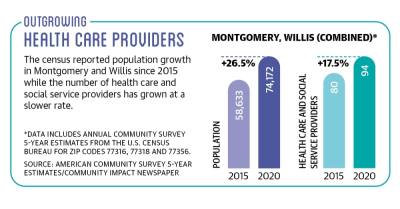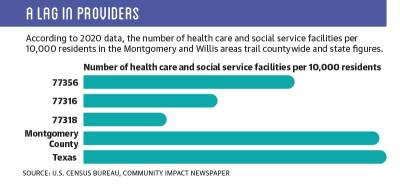Thousands of future homes are being planned for the Montgomery and Willis areas, but with HCA Houston Healthcare Conroe being the nearest hospital and data showing health care providers have lagged behind recent population growth, officials said there is need for greater health care access in those communities.
Shannan Reid, director of the Montgomery Area Chamber of Commerce, said increases in travel time spurred the chamber to assemble an economic development team to “recruit adequate health care opportunities” for the city.
“With the increase in travel time to I-45 from Montgomery due to slower speed limits and added traffic, it will be imperative to consider long-range goals to ensure Montgomery residents continue to receive prompt and effective care,” Reid said.
Census data shows health care employers have not grown at the same pace as the population in the region. In Montgomery ZIP codes 77316 and 77356, the number of health care and social assistance institutions has grown by 34.78% and 16.28%, respectively, from 2015-20, while in Willis ZIP code 77318 it declined by 7.14%, according to the U.S. Census Bureau’s Community Business Patterns dataset. The population of those three ZIP codes grew by 10.03%, 44.95%, and 31.58%, respectively, over the same time, according to the American Community Survey 5-year estimates.
Meanwhile, development continues, with residential developments underway along major roadways including I-45 and FM 1486. Despite recent and expected growth in the regions, the areas do not have large-scale hospitals, with Montgomery and Willis residents driving to HCA Conroe and hospitals in The Woodlands for hospital-level care.
Community Business Pattern data found that in 2020, approximately two-thirds of the 94 health care and social assistance businesses operating in Montgomery and Willis had less than 10 employees.
In an email to Community Impact Newspaper, Robert Sabina, HCA Houston’s chief operating officer, confirmed HCA is planning to open a surgical center in Willis, although he could not provide an opening date. He said HCA serves the area through CareNow urgent care facilities in Conroe, Montgomery and Magnolia.
“We are actively evaluating several sites of care to address the acute, primary and outpatient diagnostic needs of these rapidly growing communities, which have been long served by our hospital and medical staff,” Sabina said. “We recognize the need for services in some of these outlying areas and will continue to evaluate opportunities.”
Lone Star Family Health Center officials said the federally qualified health center is meeting some of the health care needs of north Montgomery County. With offices in Conroe and Willis, Lone Star targets populations without health insurance.
Lone Star CEO Karen Harwell said the center has continued filling a need even as the county’s northern area grows. Harwell said there is still a “huge access issue,” especially for specialist care, when it comes to low-income populations.
“Even as larger developments are happening, I thought our population would be pushed out,” Harwell said. “But we’ve seen there’s still so much demand we can’t meet in the midst of that development. We kind of run away from development, if you will, but we’ve experienced that even a booming community’s workforce relies on us.”
Accessing secondary care
According to Harwell, Lone Star—and other smaller clinics—tend to focus on providing primary care for the communities they cover. But for many clinics, anything beyond office visits and basic practices are referred out. Harwell said Lone Star is an exception, as it usually has experienced physician residents to perform mid-level care.
“We can do a lot in house, but we are not all specialties, so we are often referring out,” Harwell said.
Referring out means the clinic usually lacks the ability to control what the specialist will bill the patient, Harwell said.
Some trends in primary screening can be indicators of increasing chronic diseases that require repeated or secondary care. Bettina Beech, the University of Houston’s chief population health officer, said increasing diagnoses of obesity and Type 2 diabetes can be indicators of rising chronic disease in a population. Obesity was the most common diagnosis at Lone Star in 2021, according to the center’s report.
“When these rates [of obesity] increase, they can point to higher chronic diseases that might not be getting caught,” Beech said. “We’ve seen a plethora of urgent care services, which are sorely needed. But sometimes getting access to specialty care can be challenging—even getting an appointment.”
Ambulatory care
For Montgomery and Willis-area residents needing trauma care, the closest location is HCA Conroe, which serves as the area’s largest Level II trauma center, according to its website. According to Sabina, the hospital relies on its air transport system to reach urgent patients in outlying areas “away from major thoroughfares.”
James Campbell, the chief of emergency medical services at Montgomery County Hospital District, said another option for hospital-level treatment is through “satellite” clinics operated by other health care systems. Campbell said patients at these clinics are evaluated, and if necessary, transported to the larger hospitals in south Montgomery County.
Expansions of roadways due to transportation planning and development can impact health care, according to Campbell, who said the hospital district is involved in conversations about transit expansion as well as routes around new developments.
Although the hospital district does not tend to receive many calls from new developments, unless they are senior-focused, he said MCHD does monitor how they affect traffic.
Sabina said that while the hospital receives patients from “off the main thoroughfares,” its access to air transit and relationship with EMS services kept transit times low.
“Through our network of care in the Houston region, including Montgomery County and beyond, we have the scope of services to provide whatever services our communities may require,” Sabina said.
Future population trends
Harwell said one challenge Lone Star faces is its dependence on federal government funding, which in turn is dependent on underinsured and uninsured populations. However, the Census Bureau reported that uninsured populations in Montgomery and Willis have been decreasing since 2018. The decreasing underinsured populations mean Montgomery’s assessment as a federal grant recipient is complicated, Harwell said.
“We certainly still could open [in Montgomery], but it’s harder to justify,” she said. “The spread in incomes mean you could have a [wealthy] rancher across from a trailer park, so it’s not clearly a target for funding.”
Reid, meanwhile, said the chamber’s new economic development team would hold preliminary discussions through June on bringing health care to the Montgomery area.
“Montgomery Area Chamber has been keenly aware of the shifts in our community due to the impressive growth and proposed residential developments over the next few years,” Reid said. “This will not only bring primary employment options, but will also provide necessary health care services to our residents.”
Although HCA did not provide specifics, Sabina said it was looking into “opportunities” to expand in west Montgomery County. He said its new air transportation base in Livingston is an example of a facility that could improve service in outlying areas.
“The most important thing that we can do is maintain close relationships with the local communities that we serve to ensure that we are responsive to community needs and can truly leverage the scale of HCA Healthcare more broadly when offering new services for Conroe and the surrounding communities,” Sabina said.








